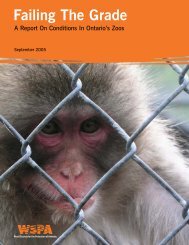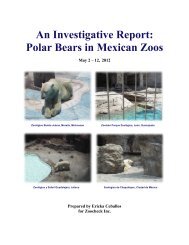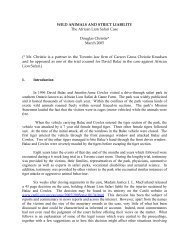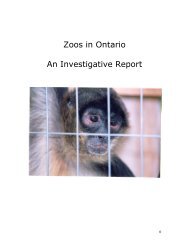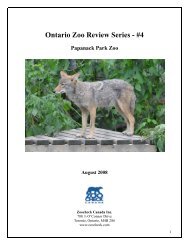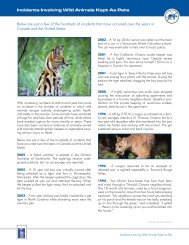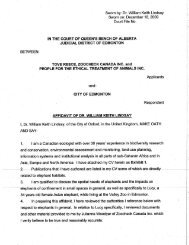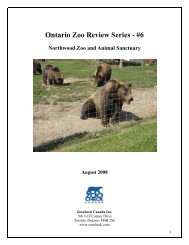STATUS OF BEAR WELFARE
STATUS OF BEAR WELFARE
STATUS OF BEAR WELFARE
Create successful ePaper yourself
Turn your PDF publications into a flip-book with our unique Google optimized e-Paper software.
Status of Bear Welfare in Cherokee, North Carolina<br />
REPRODUCTIVE STRESS<br />
The female bears in the Cherokee zoos were typically housed with a male; therefore, a female<br />
could conceivably be impregnated as often as once a year. Where the presence of cubs<br />
suppresses hormone cycles in wild female bears, sows in bear pit operations go back into heat<br />
when their cubs are removed to be hand-raised. Not only are earlier and more frequent<br />
pregnancies taxing on the body, but the emotional and mental strain of losing one’s cubs once, let<br />
alone regularly, could be extraordinary.<br />
These bears may be bred earlier and more often than bears in the wild. Male and female black<br />
bears may attain sexual maturity between their second and fourth years in captivity, but in the<br />
wild, such maturity often comes later, the age of first breeding varying between the third and fifth<br />
year. A free-ranging female grizzly would not have her first litter until she is 5 to 7 years old.<br />
In the wild, young black bears normally remain with their mothers until they are 16 to 17 months<br />
old, so female bears usually mate only every second year. Female grizzly bears only breed at<br />
three- to four-year intervals.<br />
PARASITES<br />
Evidence of intestinal parasitism was observed in the two cubs at SL (photo 13) as well as the<br />
two youngest bears at CSPB, who had hair missing from around the perianal regions on the<br />
backs of the hind limbs. This pattern of hair loss suggests rubbing of the backsides along the<br />
ground in response to itching caused by roundworms and/or resulting diarrhea. Their dull hair<br />
coats can be interpreted as another symptom of intestinal parasitism. According to the American<br />
Zoo and Aquarium Association, “Because bears are more prone to internal parasites than some<br />
other large mammals, fecal exams should be performed twice a year and treated appropriately.” 20<br />
SKIN CONDITIONS<br />
An Asiatic black bear from CSBP had a moist dermatitis on his chest under his chin (photo 14A).<br />
Moist dermatitis is usually a secondary bacterial infection of skin.<br />
Photo 14B shows a black bear at CSBP who had not shed out properly because there was a lack<br />
of appropriate surfaces to rub against. Matted fur can cause itching and skin irritation and<br />
interfere with the bear’s ability to thermoregulate.<br />
Photo 14C shows a grizzly bear at CBZ with an apparent rub wound on his head.<br />
AN INVESTIGATIVE REPORT <strong>OF</strong> CHIEF SAUNOOKE <strong>BEAR</strong> PARK, CHEROKEE <strong>BEAR</strong> ZOO, AND SANTA’S LAND | 35





